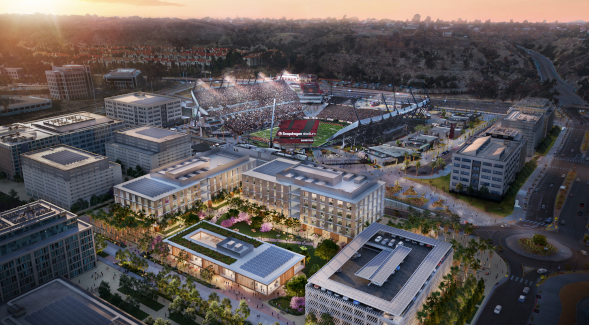SDSU Awarded $10M for Center to Foster Environmental Justice
The federally funded center, to be based at SDSU Mission Valley, will work with partner organizations across the western region of the United States.

San Diego State University will lead one of 17 centers nationwide to connect underserved communities with resources for energy and environmental justice, the Environmental Protection Agency announced today in partnership with the U.S. Department of Energy.
The SDSU Center for Community Energy and Environmental Justice will provide critical services to rural, remote, tribal and Indigenous communities to access federal resources for environmental and energy justice projects.
“We are excited to spearhead capacity-building efforts to serve the needs of communities who have historically been excluded from policy decisions and actions affecting their homes and surrounding environments,” said SDSU biology professor and project lead, Rebecca Lewison.
Over the next five years, the center and its partners will co-create accessible, multilingual, in-person and virtual services to help communities that are often most affected by environmental challenges like drought, flooding, and pollution apply for government funding.
The center’s impact will reach far beyond San Diego, with the ultimate aim of serving historically excluded communities in California, Nevada, Arizona, Hawai’i, Guam and American Samoa. To accomplish this goal, Lewison and her team will leverage SDSU’s inclusive, climate-focused initiatives, such as the Community Climate Action Network andthe Center for Regional Sustainability as well as partnerships with community-facing organizations, like the Climate Science Alliance.
“We are grateful for the incredible trust and support of the EPA and Department of Energy, which will allow us to leverage SDSU’s longstanding commitment to climate action and environmental justice,” said SDSU President Adela de la Torre.
“As the only California university selected to lead this work, this is clear recognition of our faculty’s ability and passion to foster mutually beneficial relationships with tribal and other key communities. And this empowerment focus is exactly what makes SDSU distinct as a major research university – our focus is not just on the idea, but on creating a sustainable and positive impact.”
Partner organizations span across industry and non-profit sectors including the Environmental Protection Network, Center for Creative Land Recycling, Institute for Tribal Environmental Professionals, Desert Research Institute, Pacific RISA, and the Public Health Alliance.
Other academic institutions that will also participate are Arizona State University, the University of San Diego’s Energy Policy Initiatives Center, and the University of Guam’s Center of Island Sustainability.
“SDSU has long been a central figure in regional, multi-partner projects, providing services, centering community-defined priorities and facilitating meaningful cooperative decision making,” said John Crockett, SDSU’s associate vice president for research advancement. “We are ready to apply our expertise to this opportunity.”
In addition to the $10 million from the federal government, SDSU has committed $100,000 to support the initial launch of the center.
The new center plans to establish its physical home at SDSU Mission Valley’s Innovation District, which is being designed to attract the nation’s best-in-class researchers to support the district’s many transdisciplinary hubs. These hubs will support private, public, and non-profit partners, including organizations focused on climate resilience and sustainability efforts, by cultivating rich, collaborative spaces that are easily accessible through public transit.
“SDSU’s Center for Community Energy and Environmental Justice aligns with the Innovation District’s focus on sustainable development and community input as essential to finding solutions to the environmental and health problems created by climate change,” said Hala Madanat, SDSU’s vice president for research and innovation. “We look forward to building an exemplary facility with environmental justice at its heart.”



